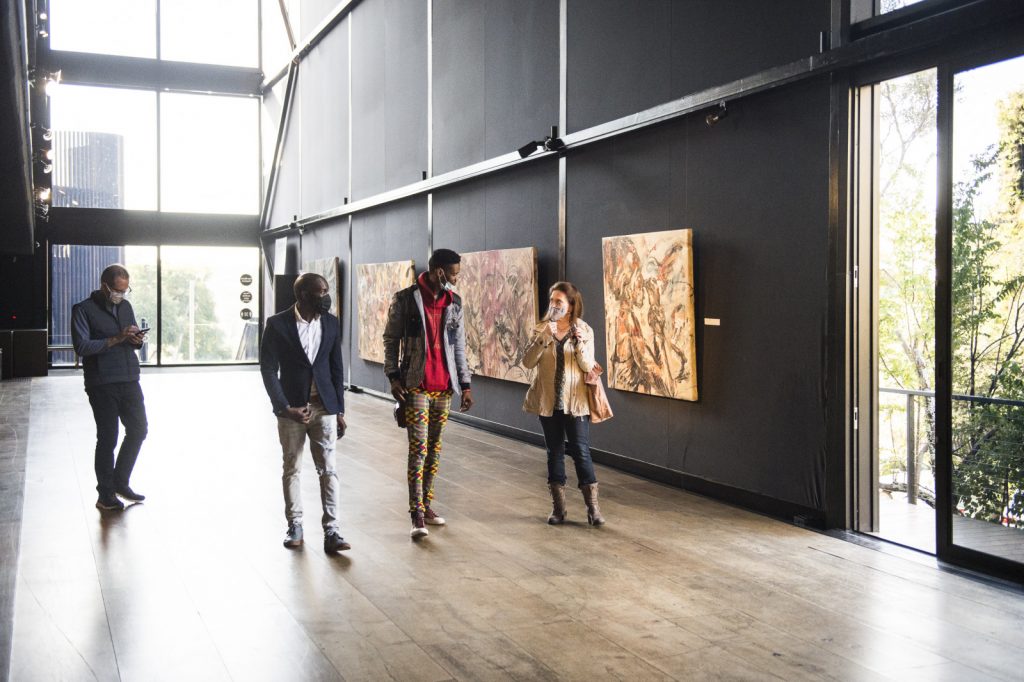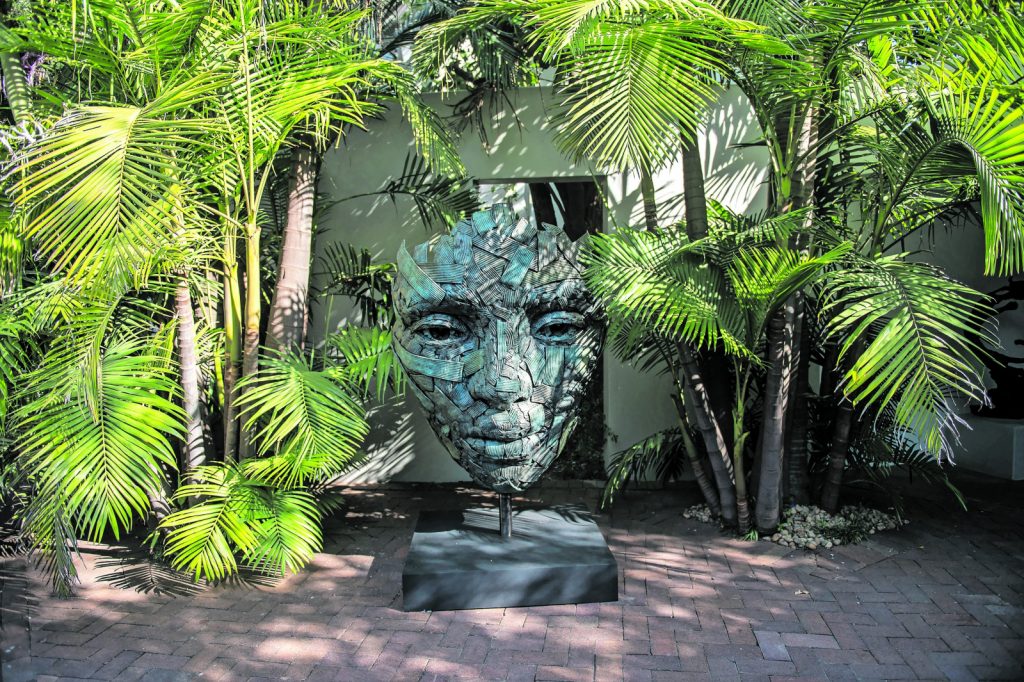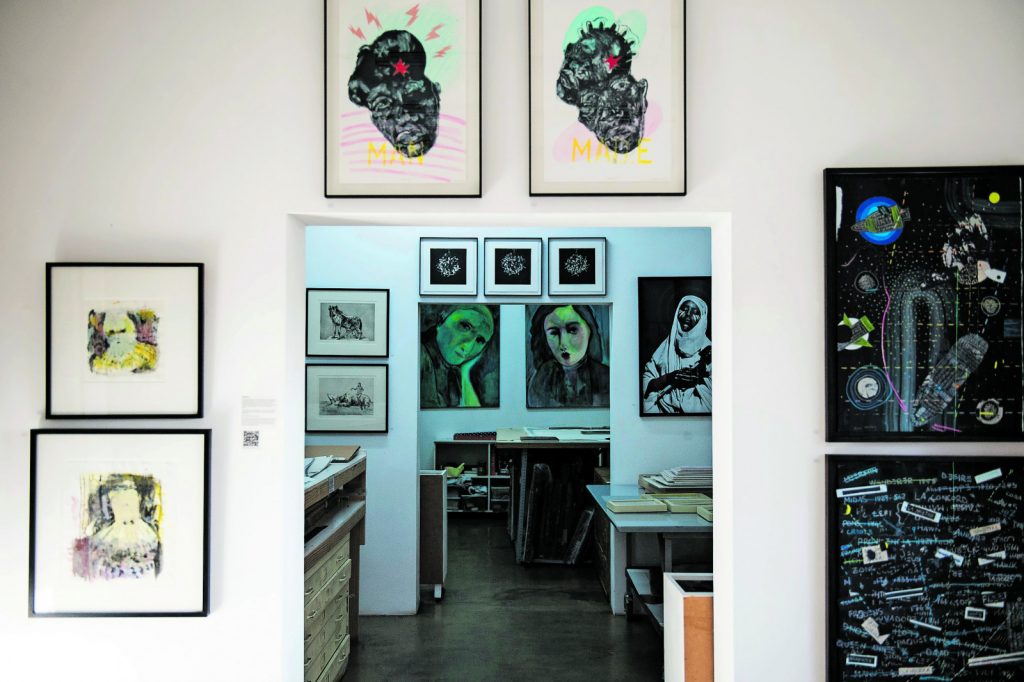Thabo the Tourist, aka Thabo Jacob Modise, (Delwyn Verasamy/M&G)
The winter sun on Keyes Art Mile — the art precinct in Rosebank, Johannesburg — can still warm anyone despite the icy temperature.
It’s here that Thabo Jacob Modise, who calls himself Thabo the Tourist, is standing with two people. One is a South African, the other an Australian, and both are eager to experience Rosebank’s art scene.
When I join with the group pleasantries are exchanged and Modise kicks things off.
“I usually start my tours at the Everard Read Gallery, the oldest gallery in the country,” says our animated tour guide.
We head down Jellicoe Avenue to the gallery, which displays modern and contemporary art. First established in 1913 in downtown Johannesburg when it was a young mining town, the gallery moved to Rosebank in the late 1970s. The gallery also has a footprint in the V&A Waterfront in Cape Town, Franschhoek and London.
As we enter the gallery, the history lesson pauses as our tour guide starts to talk art. Dressed in a colour-blocking hoodie and carrying a brown bag, Thabo the Tourist gesticulates: “This is Nandipha Mntambo’s artwork called Mediation, this is Lady Skollie and that is Blessing Ngobeni,” he says, while also explaining more about the techniques the artists use.
During this 20-minute tour, we also see artworks by Nicola Bailey, Phillemon Hlungwani and Nic Bladen. The gallery is roomy but almost every wall is adorned with artworks and sculptures are displayed on the floor and in the gardens outside.
Although Modise often interjects to talk about the artworks, the experience is leisurely as he lets us gravitate towards artworks that interest us. After everyone’s visual senses have been stimulated, Modise walks us to another gallery, Circa, which has distinct curved walls and walkway and opened in 2009 alongside the Everard Read.
 Gallery hopping: Thabo the Tourist, aka Thabo Jacob Modise, guides people through the Keyes Art Mile. (Delwyn Verasamy/M&G)
Gallery hopping: Thabo the Tourist, aka Thabo Jacob Modise, guides people through the Keyes Art Mile. (Delwyn Verasamy/M&G)
According to the website, “The curatorial directors seek to intersperse contemporary art exhibitions with human technology and scientific installations.”
Modise is the founder of Toura Travel Therapy, which offers a novel art gallery experience called Hop-On Joburg Art Galleries with Thabo the Tourist.
The hopping happens on an e-scooter, which Modise says millennials like. Tourists are first taught how to use the scooters before they head out and the streets they travel have little traffic. If someone doesn’t want to use an e-scooter, Modise calls a taxi or simply tailor-makes a walking tour.
But today is an exception; we are driven down Jan Smuts Avenue where the tour continues at the David Krut Projects, which “promotes contemporary culture in a dynamic, collaborative environment,” according to its website. It’s at 151 Jan Smuts Avenue and also at Arts on Main in Maboneng in downtown Johannesburg
When I ask Modise how he is so knowledgeable about the art being exhibited, he says the galleries send him emails about upcoming shows. He then attends the openings and walkabouts to get an in-depth understanding of the works on display. Beyond this, he does his own research.
“I came up with the idea because I wanted people to receive the healing power of art,” says Modise.
But what really underpins these art tours is Modise wants people of colour, who were previously excluded from galleries, to learn about art and investing in it.
Modise says it can be intimidating to visit an art gallery on one’s own. He explains that although these art galleries exist — some with big, beautiful and bold architectural designs — people see them as monuments and do not go inside.
“Every time I visit art galleries it is too white. I wanted to bring people of colour into art gallery spaces. I wanted to unite art and tourism in real time,” says Modise. “Some [people] are still intimidated — it’s too quiet — some think there’s an entrance fee. But it’s free, all galleries are free.”
 A striking statue stands at the Everard Read Gallery entrance. (Delwyn Verasamy/M&G)
A striking statue stands at the Everard Read Gallery entrance. (Delwyn Verasamy/M&G)
Who goes to art galleries and who does not is rooted in our country’s history of apartheid. Zaza Hlalethwa wrote in the Mail & Guardian that before 1994, black South Africans were not allowed entry into museums and art galleries. She quotes curator and cofounder of the Black Collectors Forum Andile Magengelele, who said, “Black artists were neglected by museums, collectors and art galleries. Black people weren’t even allowed into galleries and museums.”
Modise decided to anchor his business in Rosebank because of the number of art galleries in the area. “Rosebank is an art suburb. We have a lot of galleries around this area [and] I needed a place where we could hop onto as many galleries as possible, without a lot of effort. So this was the best place, plus these are galleries I used to visit.”
He proposed the idea of his business to the galleries, including his intentions and how he would package the tours. They liked his ideas.
“I knew that they wanted more people in the galleries,” he says.
BKhz, one of the galleries on Modise’s tour, believes that any new face to the gallery is always a win, whether they are buyers or not.
“Thabo acts as a kind of scaffold for culture in Johannesburg. Without his services, culturally-related spaces would need to work harder to cast their nets far and wide in order to reach people who wouldn’t naturally gravitate towards galleries, museums and theatres etc,” BKhz Gallery says in a statement.
Modise mentions that he wanted to travel the world and moving from one place to another has always fascinated him. In 2010, when South Africa hosted the Fifa World Cup, tourists descended on the country, Modise started his tourism career, but only by “default”.
 The tour by Modise also takes in the David Krut Project. (Delwyn Verasamy/M&G)
The tour by Modise also takes in the David Krut Project. (Delwyn Verasamy/M&G)
In that year, he opened a stall in Vilakazi Street in Soweto, where he sold T-shirts.
“While I was there I started being exposed to tourists. I started seeing a lot of tours coming to Vilakazi Street, of course coming to view Mandela’s house and [eat at] restaurants,” says Modise. “Right there I started to realise that I am [participating in] tourism too. The same people that came to Soweto were the ones supporting my business. So that is how I started.”
In 2019, he decided to rebrand his business as Shova Lifestyle Origin. “That is when I literally went into tourism by uniting art and tours because I strongly believe art is tourism and vice versa — we are all telling stories,” he says.
Modise says he would like to see art gallery hopping being a trend for any person living in Joburg. He plans to build solid business relationships and partnerships and expand his tours to other cities such as Pretoria and Cape Town.
A Thabo the Tourist experience costs R880 a person per tour, which includes a lunch voucher. The tours usually last for three hours. Follow Thabo The Tourist @thabothetourist on Instagram.